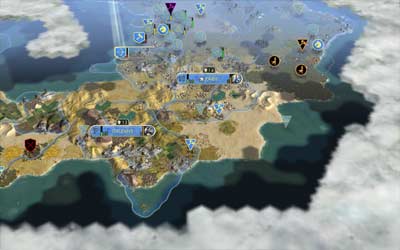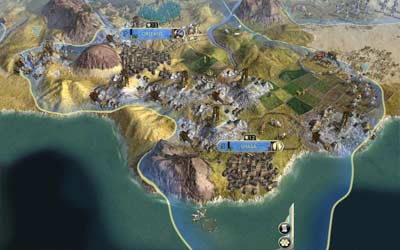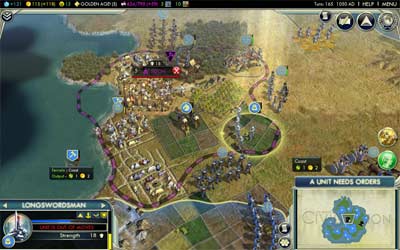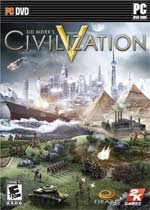There are many war strategy games that have been released, and many of them handle tactical combat and historical warfare far better than Sid Meier’s Civilization V could ever hope to achieve. However, Civ V still manages to be far better than just about every single one of those games if our near-finished preview demo is any indication (and it is.)

The advantage that Civ V brings to the table is its incredibly advanced software that literally allows you to craft history to your own liking. The developers have created worlds for you to exist in; , they’ve accurately modeled the general dispositions of different civilizations, and crafted a technology time line that is disturbingly good at mimicking reality. The only variable between Civ V’s world and the real world is you.
The player adds a new element to this boiling cauldron of political intrigue, and the result is explosive. As a strategy war game, Civ V is so much better than its forebears because the player has had a hand in every circumstance that has led to the battle. You’re not merely told “you are the 101st airborne and you must defend Bastogne!” as most strategy games would. The gravity of the battle comes not from the mission, but from the intrigue that preceded it.
The battles aren’t just interesting because you’re fighting Rome. They’re interesting because your alliance with the independent city-state of Hanoi (also Rome’s ally) made Caesar jealous, wishing to be Hanoi’s lone big brother; until your tense relations with the Roman empire were pushed over the edge as a traveling scout was caught trespassing beyond their borders, ultimately cascading into all-out war.

This isn’t the first time we’ve seen Civ V, but it was the first time we got an extensive play opportunity with a nearly finished build. We had heard all of the bullet points about why this version was going to be so much different than previous installments (that are worth restating further down the page), but we were never able to see how they would play out. Until now, it was all just words.
But now that we’ve been able to play an entire civilization from conception to completion, we’ve seen all of these elements in action. While this is still very much Civilization, a lot of the improvements are proving to be positive ones. Civilization 4 was, for all intents and purposes, a perfect game. So where do you go from there when crafting the sequel?

In short, they’ve found a way to change everything while changing nothing. Everything we love about Civilization is still identical. You still rise through the ages by advancing your civilization, conquering/wooing other civilizations, and researching new technologies. But a few key changes force you to rethink everything you know about how to do certain things.
For instance, the arrival of city-states mixes up the intricate web of diplomatic relations. You want to befriend these states because they will offer you benefits. While Sidon might offer additional military units every 17 turns, Venice will supply you with extra food. You have to choose your friends carefully. These alliances, as in the real world, can lead to amazing prosperity, but also devastating wars as more and more nations get dragged into the fray.
The other big change comes to how you move your units. The new hexagonal tiles provide more realistic topography, but they are also an essential component due to the demise of “unit stacking.” The Stack of Doom, as it was called, was a tactic that previous Civ players would use where they would pack dozens of units onto a single tile. This made for a virtually indestructible conquering force. In Civ V, you may only put one combat unit on each tile. This provides new logistical challenges as you try to get your armies across mountainous or wooded areas. It also allows new strategic opportunities to the meticulous though. Skilled strategists will wrap their units around cities, with archers protected one-row behind.
Another big addition is the Social Policies system. As your civilization progresses you’ll earn “culture” (a kind of currency) that you can spend to adopt social policies. These upgrade trees give you the chance to choose different paths for you to take. Early on, you can take the route of Honor to provide benefits to your military or, later on, take the path of commerce to increase your gold output.
Those things don’t change the soul of Civilization, but they change the way you’re able to play the game in significant enough ways that the game is still a new experience. We were especially enthusiastic about how city-states affected the political landscape.
This is one of the most celebrated franchises of all-time, and I would be doing the team at Firaxis a disservice if I called them “capable.” From their earliest efforts to 2004’s spectacular Pirates!, and now Civilization V, Firaxis has proven themselves to be a developer that can deliver extremely high quality over and over again. Civilization V seems to be absolutely no different.
Game Features:
